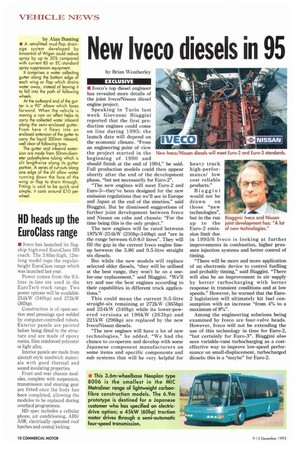New New diesels in 95
Page 12

If you've noticed an error in this article please click here to report it so we can fix it.
by Brian Weatherley
EXCLUSIVE • Iveco's top diesel engineer has revealed more details of the joint Iveco/Nissan diesel engine project.
Speaking in Turin last week Giovanni Biaggini reported that the first production engines could come on line during 1995: the launch date will depend on the economic climate. "From an engineering point of view the project started in the beginning of 1990 and should finish at the end of 1994," he said. Full production models could then appear shortly after the end of the development phase, "but not necessarily for Euro-2".
"The new engines will meet Euro-2 and Euro-3—they've been designed for the new emission regulations that we'll see in Europe and Japan at the end of the nineties," said Biaggini. But he dismissed suggestions of further joint development between Iveco and Nissan on cabs and chassis: "For the time being this is the only project."
The new engines will be rated between 187kW-254kW (250hp-340hp) and "are in the range between 6.0-8.0 litres". They will fill the gap in the current Iveco engine lineup between the 5.86 and 9.5-litre straight six diesels.
But while the new models will replace selected older diesels, "they will be utilised at the best range, they won't be on a onefor-one replacement," said Biaggini. "We'll try and use the best engines according to their capabilities in different truck applications."
This could mean the current 9.5-litre straight-six remaining at 272kW (365hp) and 254kW (340hp) while its lower-powered versions at 196kW (263hp) and 221kW (296hp) are replaced by the new Iveco/Nissan diesels.
"The new engines will have a lot of new technologies," he added. "We had the chance to co-operate and develop with some Japanese component manufacturers on some items and specific components and sub systems that will be very helpful for heavy truck high-performance/ low cost reliable products."
Biaggini would not be drawn on those "new technologies", but in the run up to the Euro-2 emission limit due in 1995/6 Iveco is looking at further improvements in combustion, higher pressure injection systems and better control of timing.
"There will be more and more application of an electronic device to control fuelling and probably timing," said Biaggini. "There will also be an improvement in air supply by better turbocharging with better response in transient conditions and at low speeds." However, he warned that the Euro2 legislation will ultimately hit fuel consumption with an increase "from 4% to a maximum of 8%".
Among the engineering solutions being examined by Iveco are four-valve heads. However, Iveco will not be extending the use of this technology in time for Euro-2, "but certainly for Euro-3". Biaggini also sees variable-vane turbocharging as a costeffective way to improve low-speed performance on small-displacement, turbocharged diesels: this is a "maybe" for Euro-2.
1 Biaggini: Iveco and Nissan joint development has: "A lot of new technologies."


























































































